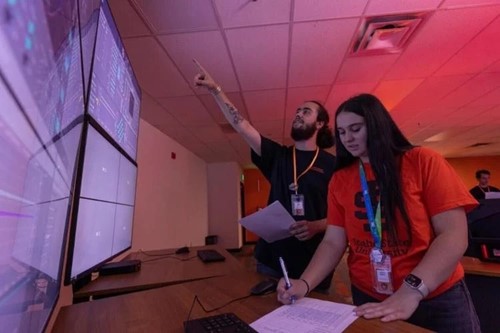Mackenzie Gorham, a clinical instructor of nuclear operations at ISU, said the school’s E2 Center is the largest one outside of the one at NuScale’s headquarters in Oregon.
The E2 Center gives students an opportunity to learn how to work in a control room for NuScale reactor plants, ISU said in a news release, adding this will help students become qualified to work in places such as Idaho National Laboratory.
In a video announcing the center’s opening, Gorham said the College of Technology’s nuclear operations technology program is a two-year associate of applied science degree and that 96% of the program’s graduates have employment in the nuclear industry with an average starting salary between $70,000 and $100,000.
Vince Bowen, the College of Technology’s executive director/department chairman of energy systems technology and education, said in the video that nuclear energy is the future of how electricity will be generated worldwide and that the new center will allow the program’s graduates to play an important role in that future.
Debbie Ronneburg, the interim dean of ISU’s College of Technology, opened the center’s Oct. 26 grand opening by introducing several special guests from NuScale Power, the College of Technology as well as local and state government officials such as Mayor Brian Blad and state Rep. Dustin Manwaring.
“In the spring of 2021, Governor Brad Little signed the Building Idaho’s Future Bill,” Ronneburg said. “It created one-time funds for strategic investments in career and technical education.”
Ronneburg said the College of Technology received $1 million to fund this project thanks to the bill. She said the funding was used to modernize and expand the college’s programs that align with regional labor market needs.
“Over the year, we were able to purchase cutting-edge equipment for various programs at the College of Technology, including nuclear operations technology,” she said.
Ronneburg said the investment led to the partnership with NuScale Power, which led it to build the reactor control room and simulation lab.
Doug Bowen, supervisor of plant operations at NuScale Power, expressed his excitement about the completion of the project.
“… We’ll truly be training the future operators for the Idaho Nuclear Lab site,” he said
During his comments at the ceremony ISU’s Vince Bowen told the audience how excited he is that the university now has the simulator. He also showed the attendees the video of ISU instructors and students discussing the reactor control room and simulation lab and the opportunities it will give to students.
In the video, Vince Bowen said the center could allow the school to become “a hotbed for operators for NuScale reactors. And the thing about it is (the students are) going to get experience regardless on new reactors.”
Once the video ended, members of the audience were able to observe ISU students working in the simulation lab. The students demonstrated working procedures during both normal and abnormal settings, such as during an earthquake.
The university will continue to reach out to the community with tours and demonstrations of the new facility for community leaders, K-12 students and anyone in the community who is interested.
The Post Register contributed to this article.
